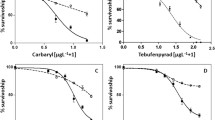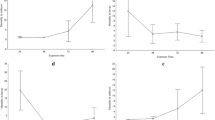Abstract
Cypermethrin is one of the most widely used pesticides due to its low mammalian and bird toxicity, but it is extremely toxic to aquatic organisms. The aim of the present study was to evaluate the toxicity of a commercial formulation of cypermethrin on the embryo–larval development of Rhinella arenarum. An ecological risk assessment based on the hazard quotient (HQ) approach was performed. The results showed that cypermethrin toxicity was stage-dependent and dramatically increased during the larval period. Thus, larvae were more sensitive than embryos, obtaining at the end of the experiment a 336-h median lethal concentration (LC50) of 0.65 μg cypermethrin/L. Cypermethrin exposure caused morphological abnormalities such as general underdevelopment, edema, gill malformations, and behavioral alterations as hyperkinesia and spasmodic contractions. The 168-h teratogenic index was 5, implying a high risk for embryos to be malformed in the absence of significant embryonic lethality. Based on the results of the toxicity effects and the ecological risk assessed (HQ for chronic exposure > level of concern), this pesticide should be considered as a direct (effects on survival) or indirect (severe sublethal effects) risk for conservation purposes of this amphibian in agroecosystems.



Similar content being viewed by others
References
Agostini MG, Natale GS, Ronco AE (2010) Lethal and sublethal effects of cypermethrin to Hypsiboas pulchellus tadpoles. Ecotoxicology 19(8):1545–1550
American Public Health Association (2005) Standard methods for the examination of water and wastewater, 15th edn. American Public Health Association, Washington DC
Aronzon CM, Sandoval MT, Herkovits J, Pérez-Coll CS (2011) Stage-dependent toxicity of 2,4-dichlorophenoxyacetic on the embryonic development of a South American toad, Rhinella arenarum. Environ Toxicol 26(4):373–381
ASTM (American Society for Testing and Materials) (1993) Standard guide for conducting the frog embryo teratogenesis assay—Xenopus (FETAX). In Standards on Aquatic Toxicology and Hazard Evaluation. Philadelphia, PA, pp 1199–1209
Bantle JA, Dumont JN, Finch RA, Linder G, Fort DJ (1998) Atlas of abnormalities. A guide for the performance of FETAX, 2nd edn. Oklahoma State University, Stillwater, Oklahoma
Berrill M, Bertram S, Wilson A, Louis S, Brigham D, Stromberg C (1993) Lethal and sublethal impacts of pyrethroid insecticides on amphibian embryos and tadpoles. Environ Toxicol Chem 12:525–539
Biga LM, Blaustein AR (2013) Variations in lethal and sublethal effects of cypermethrin among aquatic stages and species of anuran amphibians. Arch Environ Contam Toxicol 47(4):489–495
Boyer R, Grue CE (1995) The need for water quality criteria for frogs. Environ Health Perspect 103(4):352–357
CASAFE (Cámara Argentina de Sanidad Agropecuaria y Fertilizantes) (2010) Mercado argentino de productos fitosanitarios 2010., http://www.casafe.org/pdf/estadisticas/Informe%20Mercado%20Fitosanitarios%202010.pdf
Casco VH, Marín L, Vergara MN, Lajmanovich RC, Izaguirre MF, Peralta Soler A (2006) Apoptotic cell death in the central nervous system of Bufo arenarum tadpoles induced by cypermethrin. Cell Biol Toxicol 22(3):199–211
David M, Marigoudar SR, Patil VK, Halappa R (2012) Behavioral, morphological deformities and biomarkers of oxidative damage as indicators of sublethal cypermethrin intoxication on the tadpoles of D. melanostictus (Schneider, 1799). Pestic Biochem Physiol 103:127–134
Del Conte E, Sirlin L (1951) The first stages of Bufo arenarum development. Acta Zool Lilloana 12:495–499
Edwards R, Millburn P, Huston DH (1987) The toxicity and metabolism of the pyrethroids cis-trans-cypermethrin in rainbow trout, Salmo gairneri. Xenobiotica 17:1175–1193
Ghodageri MG, Pancharatna K (2011) Morphological and behavioral alterations induced by endocrine disrupters in amphibian tadpoles. Toxicol Environ Chem 93(10):2012–2021
Glickman AH, Weitman SD, Lech JJ (1982) Differential toxicity of trans-permethrin in rainbow trout and mice. I. Role of biotransformation. Toxicol Appl Pharmacol 66(2):153–161
Grajeda CP, Ramirez MVM, Gonzalez ME (2004) Vitamin C protects against in vitro cytotoxicity of cypermethrin in rat hepatocytes. Toxicol In Vitro 18:13–19
Haya K (1989) Toxicity of pyrethroid insecticides to fish. Environ Toxicol Chem 8:381–392
Hayes T, Haston K, Tsui M, Hoang A, Haefelle C, Vonk A (2003) Atrazine induced hermaphroditism at 0.1 ppb in American leopard frogs (Rana pipiens): late filed evidence. Environ Health Perspect 111:568–575
Herkovits J, Perez-Coll CS (1999) Bioensayos para test de toxicidad con embriones de anfibio (“Anfitox”). Ing Sanitaria y Ambiental 42:24–30
Herkovits J, Perez-Coll CS (2003) AMPHITOX: a customized set of toxicity tests employing amphibian embryos. Symposium on multiple stressor effects in relation to declining amphibian populations. In: Linder GL, Crest S, Sparling D, Little EE (eds) Multiple stressor effects in relation to declining amphibian populations. ASTM International STP 1443, USA, pp 46–60
Herkovits J, Pérez-Coll C, Herkovits FD (2002) Ecotoxicological studies of environmental samples from Buenos Aires area using a standardized amphibian embryo toxicity test (AMPHITOX). Environ Pollut 116(1):177–183
Izaguirre MF, Lajmanovich RC, Peltzer PM, Peralta Soler A, Casco VH (2000) Cypermethrin-induced apoptosis in the telencephalon of Physalaemus biligonigerus tadpoles (Anura: Leptodactylidae). Bull Environ Contam Toxicol 65(4):501–507
Jergentz S, Mugni H, Bonetto C, Schulz R (2005) Assessment of insecticide contamination in runoff and stream water of small agricultural streams in the main soybean area of Argentina. Chemosphere 61(6):817–826
Kamrin MA (2000) Pesticide profiles toxicity. Environment impact and fate. CRC, Boca Raton
Little EE, Archeski RD, Flerov BA, Kozlovskaya VI (1990) Behavioral indicators of sublethal toxicity in rainbow trout. Arch Environ Contam Toxicol 19(3):380–385
Mann RM, Bidwell JR (1999) The toxicity of glyphosate and several glyphosate formulations to four species of southwestern Australian frogs. Arch Environ Contam Toxicol 36(2):193–199
Marino D, Ronco EA (2005) Cypermethrin and chlorpyrifos concentration levels in surface water bodies of the Pampa Ondulada, Argentina. Bull Environ Contam Toxicol 75(4):820–826
Mishra D, Srivastava SK, Srivastava AK (2005) Effects of the insecticide cypermethrin on plasma calcium and ultimobranchial gland of a teleost, Heteropneustes fossilis. Ecotoxicol Environ Saf 60:193–197
Narahashi T (2000) Neuroreceptors and ion channels as the basis for drug action: past, present, and future. J Pharmacol Exp Ther 294:1–26
Oros DR, Werner I (2005) Pyrethroid insecticides: an analysis of use patterns, distributions, potential toxicity and fate in the Sacramento-San Joaquin delta and Central Valley. White Paper for the Interagency Ecological Program. SFEI Contribution 415. San Francisco Estuary Institute, Oakland, CA, USA
Paulov S (1990) Potential impact of pyrethroids (cypermethrin) on the model amphibians (Rana temporaria). Biologia (Bratislava) 45:133–139
Pisanó A (1956) Efficienza funzionale e structura dell’ ipofisi di anfibio. Arch Zool Ital 42:221–227
Relyea RA (2009) A cocktail of contaminants: how mixtures of pesticides at low concentrations affect aquatic communities. Oecologia 159(2):363–376
Saha S, Kaviraj A (2008) Acute toxicity of synthetic pyrethroid cypermethrin to some freshwater organisms. Bull Environ Contam Toxicol 80:49–52
Siegfried BD (1993) Comparative toxicity of pyrethroid insecticides to terrestrial and aquatic insects. Environ Toxicol Chem 12(9):1683–1689
Soderlund DM, Clark JM, Sheets LP, Mullin LS, Piccirillo VJ, Sargent D, Stevens JT, Weiner ML (2002) Mechanisms of pyrethroid neurotoxicity: implications for cumulative risk assessment. Toxicology 171:3–59
Suvetha L, Ramesh M, Saravanan M (2010) Influence of cypermethrin toxicity on ionic regulation and gill Na (+)/K (+)-ATPase activity of a freshwater teleost fish Cyprinus carpio. Environ Toxicol Pharmacol 29(1):44–49
Svartz GV, Pérez-Coll CS (2013) Comparative toxicity of cypermethrin and a commercial formulation on Rhinella arenarum larval development (Anura: Bufonidae). Int J Environ Health 6(4):320–329
USEPA (US Environmental Protection Agency) (1988) Users guide for a computer program for PROBIT analysis of data from acute and short-term chronic toxicity test with aquatic organisms. Biological Methods, Environmental Monitoring and Support, Laboratory, Cincinnati, OH, USA
USEPA (US Environmental Protection Agency) (1989) Pesticide fact sheet number 199: cypermethrin. US EPA, Office of Pesticide Programs, Registration Div, Washington, DC
USEPA (U.S. Environmental Protection Agency) (1998) Guidelines for ecological risk assessment. Ecological risk assessment step 2. United States Environmental Protection Agency, Washington, DC
USEPA (US Environmental Protection Agency) (2008) Reregistration eligibility decision for cypermethrin (revised 1/14/08). OPP/2005/0293. US Environmental Protection Agency, Washington, DC
Vaalavirta L, Tahti H (1995) Astrocyte membrane Na+, K (+)-ATPase and Mg (2+)-ATPase as targets of organic solvent impact. Life Sci 57:2223–2230
Vijverberg HP, van den Bercken J (1990) Neurotoxicological effects and the mode of action of pyrethroid insecticides. Crit Rev Toxicol 21:105–126
Acknowledgments
Gabriela V. Svartz, Carolina M. Aronzon and Cristina S. Pérez Coll are members of the Consejo Nacional de Investigaciones Científicas y Técnicas (CONICET), Argentina, and Universidad Nacional de San Martín (UNSAM), Argentina. We wish to thank Instituto Massone S.A. for providing the human chorionic gonadotropin and Fix Sudamericana Laboratory for the determinations of cypermethrin in water.
Author information
Authors and Affiliations
Corresponding author
Additional information
Responsible editor: Philippe Garrigues
Rights and permissions
About this article
Cite this article
Svartz, G., Aronzon, C. & Pérez Coll, C. Comparative sensitivity among early life stages of the South American toad to cypermethrin-based pesticide. Environ Sci Pollut Res 23, 2906–2913 (2016). https://doi.org/10.1007/s11356-015-5547-7
Received:
Accepted:
Published:
Issue Date:
DOI: https://doi.org/10.1007/s11356-015-5547-7




